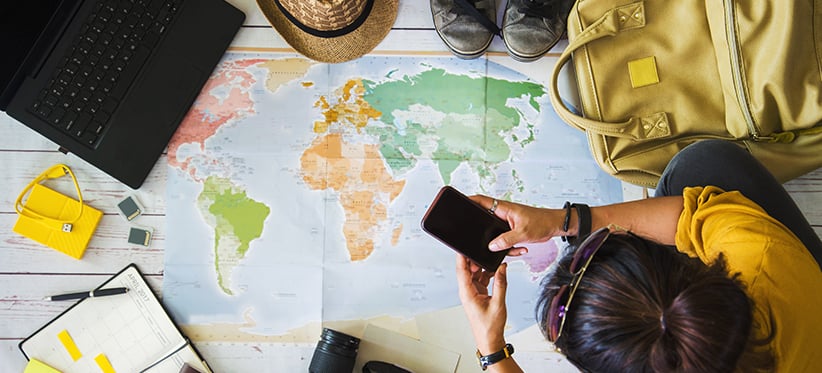Technology has come a long way since commercial aircraft first carried passengers in the 1920s. Back then, airplanes were cold, loud, and unpressurized. They carried fewer than 20 people and flew at a maximum of 3,000 feet.
Although the technology must have seemed amazing at the time, there’s certainly no comparison to what’s possible with today’s tech. Here’s what OAG predicts will be the top travel technology themes in 2020.
Voice Technology Will Change How Travelers Book
And smart speaker use is growing rapidly. Nearly 35 percent of U.S. households have at least one smart speaker, and what’s now a nearly-$12-billion market is expected to be a $27-billion one by 2022.
A few years ago, OAG asked more than 2,000 travelers to identify which platforms and methods they would be comfortable booking travel through: 25% said mobile assistants like Siri and Okay Google and 18% said voice automated systems like Google Home and Amazon Echo. If we asked that same question again today, we’d bet the numbers would be even higher.
Some airlines themselves already allow voice-enabled check-in, flight information, and status. EasyJet will soon offer its passengers the ability to book flights using voice recognition technology on the airline’s iOS app. The airline says passengers using voice will be able to book a flight in seconds after giving just a few vocal replies, as opposed to typing at least 12 commands.
Prescriptive Analytics Will Be the New Predictive
Travel companies are swimming in big data. The key, of course, is turning that data into valuable and useful insights. In 2020, we predict more travel companies will go beyond predictive analytics—using historical patterns and trends—to the emerging science of prescriptive analytics.
John Carney, Chief Data Scientist at OpenJaw Technologies, calls prescriptive analytics the “final frontier” for any travel retailer using Big Data. Prescriptive means going beyond merely using customer insights gleaned from predictive analytics to using that information to identify the next best action for that particular customer. It balances the traveler’s needs at each step of the customer journey with those of the business—carefully matching demand (the customer’s desire) with supply (the travel product).
The Emergence of Super Apps
Think about how many travel-related apps a businessperson has on his or her smartphone. There’s one for each airline they fly as well as apps for travel agencies, train schedules, hotels, and more.
OAG recently analyzed its findings from three recent consumer surveys to determine what travelers want to see in a super-app platform. It found 78 percent of people want the app to show flight delays and cancellation predictions. Seventy-seven percent want to see estimated security wait times, and 75 percent want updates on expected boarding times. Travelers want a super-app to allow payment via PayPal (59%) and would consider using it for gate-side food delivery and pickup (70% overall; 91% of Millennials).
Second Cities Will Rise in Importance as Destinations
A “second city” travel destination is one that’s not the obvious travel destination in a particular country. Paris, for example, is a first city, and Marseille is a second city. More travelers will travel to second cities in 20202, which lets them avoid the tourist crush, pay less, and have a more authentic experience rather than one that caters to visitors. Second-city travel can also help manage over-tourism and create less impact on the environment.
Booking.com says 54 percent of global travelers want to play a part in reducing over-tourism. Fifty-one percent say they would change their destination for a lesser-known but similar place if they knew it would have less of an impact. We foresee more travel companies finding ways to suggest second cities to potential travel clients in 2020 – and airlines and airports thinking differently about their service, destination and schedule offerings.
More Will Offer (and Accept) Wildcard Destinations
Just as many travelers are open to second city-vacations, more than 59 percent of people planning trips are interested in wildcard options—smart and unexpected travel destinations, chosen for them by technology, that they might not otherwise have discovered. This group relishes the idea of unexpected and surprising options, tailored to their tastes, that introduce them to a new and memorable place. Expect to see more OTAs and vacation planning apps to offer wildcards, fed by richer route and connection data, facilitated by artificial intelligence (AI) and machine learning that suggests places to visit, activities to see and do, and places to stay.
Sustainable air travel will Dominate the Headlines and Reshape Travel Booking
Green travel, or eco-friendly travel, will rule the travel landscape in 2020. Today’s consumers are concerned about climate change – and the travel market makes a substantial impact, especially air travel, where we have seen the spotlight increase on airlines and their environmental impact.
In 2020, we’ll see more consumers make active travel choices – including which carriers they fly and where they stay – based on the carbon footprint of their trips. This will force airlines, OTAs, meta search engines and destinations to be more transparent about sustainability during the search and booking process. This includes green ratings, emissions information, carbon impact, the option to purchase carbon credits and more.


